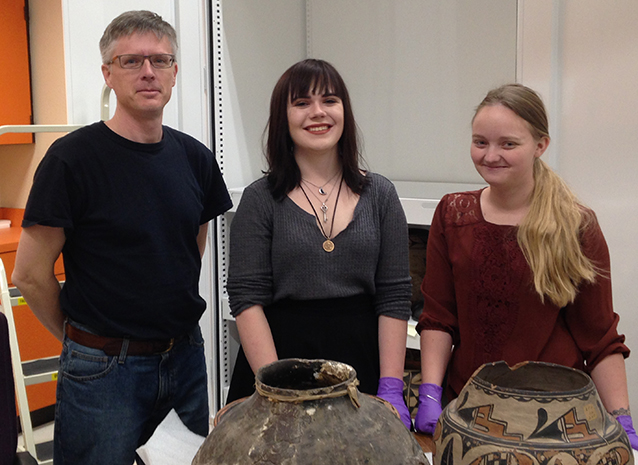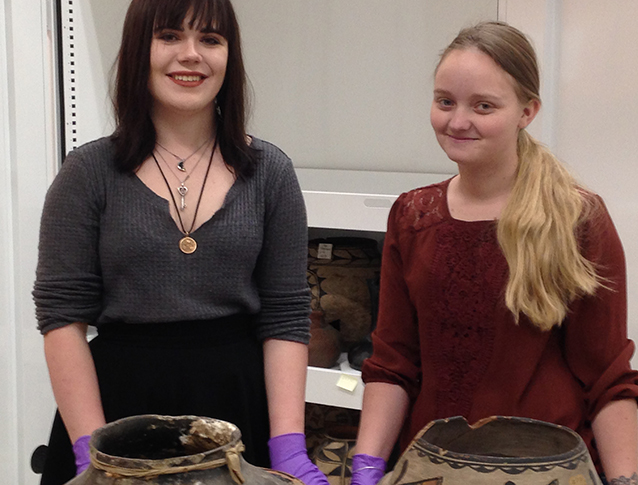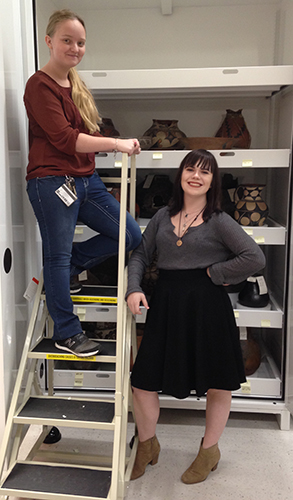Exhibitions
Anthropology Majors, Shelby Hart (far right) and Liz Jennings (center) are dedicating their time to the Anthropology department’s Southwest Native American Pottery Collection in collaboration with Dr. Andy Creekmore (far left). Their project is constructing a 3D database of the entire artifact in the collection to be accessible to others.

- Home
- Books
- Essays
- Interviews
- Multimedia
- UNC Student Engagement
- Exhibitions
- Anthropology Opportunities
Contact Us
Editor at Large
Editors
- Grace Carmichael Davis
- Madison Jansen
Like Us on Facebook:
Shelby Hart’s Dedication to Pottery at UNC

McNair Scholars Program member and Anthropology Major, Shelby Hart (right), is constructing a 3D database of the entire artifact in the collection to be accessible to others.
As a part of the UNC chapter of the McNair Scholars Program, I have been working on an independent research project involving the anthropology department’s collection of Southwest Native American pottery. Professor Andrew Creekmore provided aid and support during my research process.
McNair guides students through a yearlong research project in which the first half of the year is based on creating an original research topic and building a project proposal with a strong review of literature. The second half focuses on performing the research and writing up results in the form of a potential academic journal article. Research is presented at various stages at the 2018 UNC Research Day and at a national McNair conference in Buffalo, NY during July 2018.
For the first stage, I wanted to look at the use of technology in museums and found that it mostly centered on the incorporation of audio or standard digital images. I recognized an opportunity and interest of museums for bringing 3D technology into use and into the museums’ missions. My research centered on accessibility to the artifacts on a wider level, meaning that more people would be able to see the artifacts. My research question focused on the feasibility of incorporating photogrammetry as a means of museums and other institutions to make their collections more accessible. I argue that photogrammetry is financially manageable but requires a large time commitment.
In doing my research, I utilized the anthropology style of participant observation where I acted as a participant in 3D modeling to gain insider knowledge about the process and what it entails. I created one digital model from 235 photographs, spent approximately 15-20 hours masking each of those photos, and another 8-10 hours building the model in Agisoft Photoscan. In my research, I also attempted to utilize the digital 3D model I created as information to use for 3D printing replicas. I ran into issues with converting the data into the proper format and currently have not been able to accomplish this. I plan to continue working on digital models and find a means of converting into 3D printable formats without special conversion software.
The larger outcomes of my research involved the assessment of photogrammetry for making artifacts more accessible. I imagine a future based on this technology that allows for a Library of Congress type database for three-dimensional object models. Virtual reality exhibits are also a potential for this in the future and I hope to work on projects of this sort.
University of Northern Colorado gives Elizabeth Jennings an Opportunity to Succeed

Liz Jennings (right) an Anthropology Major, achieved participation in UNC’s Upper Division Honors program that enabled her to conduct research and acquire lifelong experiences. Her research project will be assessable to all UNC students. Jennings is creating an Ancestral pueblo pottery case that will be on display by next year.
Last semester I was fortunate enough to have the Upper Division Honors program at UNC accept me and to have the ability to not only conduct research, but to also gain practical work experience while doing so. My project for the Honors program is an applied project in which I will be creating an exhibit for Michener Library of Ancestral Pueblo artifacts. I have also been creating pottery mounts, and next semester I will begin 3D modeling pottery from my exhibition to feature in an online version of that same exhibit. The goal is that this will encourage research and promote accessibility of these amazing artifacts. My project also contains a research component in which I will be answering the following question: What is the proper cataloguing procedure and fulfillment of the Ancestral Pueblo pottery that will be on exhibition in fall 2018. In answering this question, I will also be creating a catalogue for these artifacts so that it may be published.
I cannot express what an amazing opportunity this whole project is. I would not be able to do this work without the guidance, support, and encouragement of the Anthropology Department here at UNC, and I would personally like to thank Dr. Andrew Creekmore as both my academic and thesis advisor. I would not have even thought of doing work like this, and I certainly would not have been successful without his help and direction. As a student who aspires to become a museum curator these experiences are invaluable. Not many undergraduate students are able to get such exciting work experience, but I feel that within the Anthropology Department there is a sincere interest from the entire faculty for their students to not only succeed, rather students excel in their field. Going forward, I cannot wait to expand upon my knowledge and experiences.
Shelby Hart’s Dedication to Pottery at UNC

McNair Scholars Program member and Anthropology Major, Shelby Hart (right), is constructing a 3D database of the entire artifact in the collection to be accessible to others.
As a part of the UNC chapter of the McNair Scholars Program, I have been working on an independent research project involving the anthropology department’s collection of Southwest Native American pottery. Professor Andrew Creekmore provided aid and support during my research process.
McNair guides students through a yearlong research project in which the first half of the year is based on creating an original research topic and building a project proposal with a strong review of literature. The second half focuses on performing the research and writing up results in the form of a potential academic journal article. Research is presented at various stages at the 2018 UNC Research Day and at a national McNair conference in Buffalo, NY during July 2018.
For the first stage, I wanted to look at the use of technology in museums and found that it mostly centered on the incorporation of audio or standard digital images. I recognized an opportunity and interest of museums for bringing 3D technology into use and into the museums’ missions. My research centered on accessibility to the artifacts on a wider level, meaning that more people would be able to see the artifacts. My research question focused on the feasibility of incorporating photogrammetry as a means of museums and other institutions to make their collections more accessible. I argue that photogrammetry is financially manageable but requires a large time commitment.
In doing my research, I utilized the anthropology style of participant observation where I acted as a participant in 3D modeling to gain insider knowledge about the process and what it entails. I created one digital model from 235 photographs, spent approximately 15-20 hours masking each of those photos, and another 8-10 hours building the model in Agisoft Photoscan. In my research, I also attempted to utilize the digital 3D model I created as information to use for 3D printing replicas. I ran into issues with converting the data into the proper format and currently have not been able to accomplish this. I plan to continue working on digital models and find a means of converting into 3D printable formats without special conversion software.
The larger outcomes of my research involved the assessment of photogrammetry for making artifacts more accessible. I imagine a future based on this technology that allows for a Library of Congress type database for three-dimensional object models. Virtual reality exhibits are also a potential for this in the future and I hope to work on projects of this sort.
University of Northern Colorado gives Elizabeth Jennings an Opportunity to Succeed

Liz Jennings (right) an Anthropology Major, achieved participation in UNC’s Upper Division Honors program that enabled her to conduct research and acquire lifelong experiences. Her research project will be assessable to all UNC students. Jennings is creating an Ancestral pueblo pottery case that will be on display by next year.
Last semester I was fortunate enough to have the Upper Division Honors program at UNC accept me and to have the ability to not only conduct research, but to also gain practical work experience while doing so. My project for the Honors program is an applied project in which I will be creating an exhibit for Michener Library of Ancestral Pueblo artifacts. I have also been creating pottery mounts, and next semester I will begin 3D modeling pottery from my exhibition to feature in an online version of that same exhibit. The goal is that this will encourage research and promote accessibility of these amazing artifacts. My project also contains a research component in which I will be answering the following question: What is the proper cataloguing procedure and fulfillment of the Ancestral Pueblo pottery that will be on exhibition in fall 2018. In answering this question, I will also be creating a catalogue for these artifacts so that it may be published.
I cannot express what an amazing opportunity this whole project is. I would not be able to do this work without the guidance, support, and encouragement of the Anthropology Department here at UNC, and I would personally like to thank Dr. Andrew Creekmore as both my academic and thesis advisor. I would not have even thought of doing work like this, and I certainly would not have been successful without his help and direction. As a student who aspires to become a museum curator these experiences are invaluable. Not many undergraduate students are able to get such exciting work experience, but I feel that within the Anthropology Department there is a sincere interest from the entire faculty for their students to not only succeed, rather students excel in their field. Going forward, I cannot wait to expand upon my knowledge and experiences.

